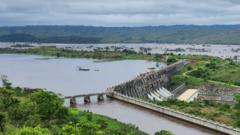**Exploring the potential of Roman-era materials, scientists aim to improve the sustainability and longevity of modern concrete.**
**Reviving Roman Engineering: A Greener Future for Concrete**

**Reviving Roman Engineering: A Greener Future for Concrete**
**Researchers Turn to Ancient Techniques to Combat Modern Concrete's Environmental Impact**
In June, Italy's Ministry of Culture made an exciting announcement regarding an excavation of a new, yet-to-be-revealed chamber in the iconic ruins of Pompeii. Shortly thereafter, an assembly of archaeologists gathered to take in the marvels within, characterized by vibrant blue frescoes—unique for their historical significance—and other intricate agricultural depictions that have remarkably endured the ravages of time.
Amongst the archeological wonders, one individual caught up in the ancient allure was Dr. Admir Masic, a chemist from the Massachusetts Institute of Technology. While onlookers were drawn to the artwork, Dr. Masic’s intrigue lay with an inconspicuous mound of sandy earth situated nearby. This unassuming material, he explained, served as a precursor to concrete, integral to the expansive engineering feats of the Roman Empire, which included aqueducts vital for water supply and hygiene in cities like Pompeii.
Dr. Masic emphasized the importance of this advancement: “The ability to bring water to the city facilitated hygiene and urban development, enabling the Romans to replicate their achievements across diverse regions.” He gestured broadly, embodying the vast network of cities the Romans established.
In stark contrast, today’s most prevalent construction material, Portland cement, emerged in 19th century England, offering a combination of affordability and strength that revolutionized building practices. However, its durability falls short compared to that of ancient Roman concrete, which is prone to cracking over time and ultimately vulnerable to water damage.
Furthermore, concrete production is a leading contributor to global pollution, accounting for 8% of total CO2 emissions. This has prompted researchers like Dr. Masic to delve into ancient Roman techniques to craft contemporary alternatives that are both environmentally friendly and robust.
Geologist Marie Jackson from the University of Utah noted that “Roman marine concretes have withstood some of the harshest conditions on Earth without any maintenance.” This revelation sparks hope and determination among scientists to merge ancient wisdom with modern technology for a more sustainable future in construction.
Amongst the archeological wonders, one individual caught up in the ancient allure was Dr. Admir Masic, a chemist from the Massachusetts Institute of Technology. While onlookers were drawn to the artwork, Dr. Masic’s intrigue lay with an inconspicuous mound of sandy earth situated nearby. This unassuming material, he explained, served as a precursor to concrete, integral to the expansive engineering feats of the Roman Empire, which included aqueducts vital for water supply and hygiene in cities like Pompeii.
Dr. Masic emphasized the importance of this advancement: “The ability to bring water to the city facilitated hygiene and urban development, enabling the Romans to replicate their achievements across diverse regions.” He gestured broadly, embodying the vast network of cities the Romans established.
In stark contrast, today’s most prevalent construction material, Portland cement, emerged in 19th century England, offering a combination of affordability and strength that revolutionized building practices. However, its durability falls short compared to that of ancient Roman concrete, which is prone to cracking over time and ultimately vulnerable to water damage.
Furthermore, concrete production is a leading contributor to global pollution, accounting for 8% of total CO2 emissions. This has prompted researchers like Dr. Masic to delve into ancient Roman techniques to craft contemporary alternatives that are both environmentally friendly and robust.
Geologist Marie Jackson from the University of Utah noted that “Roman marine concretes have withstood some of the harshest conditions on Earth without any maintenance.” This revelation sparks hope and determination among scientists to merge ancient wisdom with modern technology for a more sustainable future in construction.



















